EQDI6018 - A Report on Equality, Diversity & Policies in Shell Company
VerifiedAdded on 2023/05/30
|13
|3434
|323
Report
AI Summary
This report provides an analysis of equality and diversity within Shell Company, focusing on its policies and practices. It identifies forms of diversity, reasons for growth, and inequalities in opportunity and circumstances. The report discusses the advantages of equal opportunities in a diverse business environment and examines organizational policies designed to promote equality, along with potential problems in applying legislation. Strengths and weaknesses of policies like equal gender pay and disability policies are evaluated. The report concludes with recommendations for improving diversity management and organizational strategies to align with HR and business objectives. Desklib offers a variety of solved assignments and past papers for students.
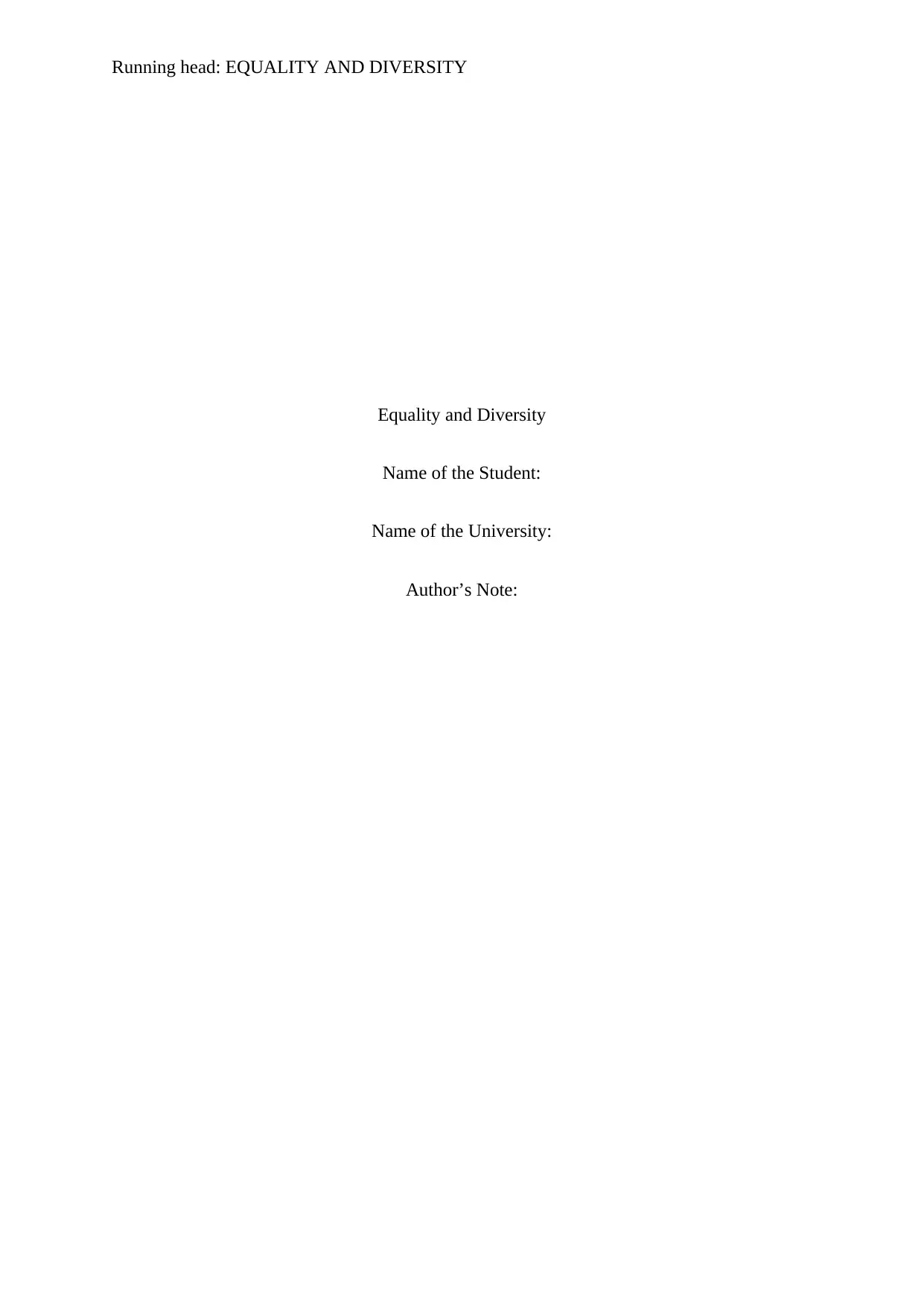
Running head: EQUALITY AND DIVERSITY
Equality and Diversity
Name of the Student:
Name of the University:
Author’s Note:
Equality and Diversity
Name of the Student:
Name of the University:
Author’s Note:
Paraphrase This Document
Need a fresh take? Get an instant paraphrase of this document with our AI Paraphraser
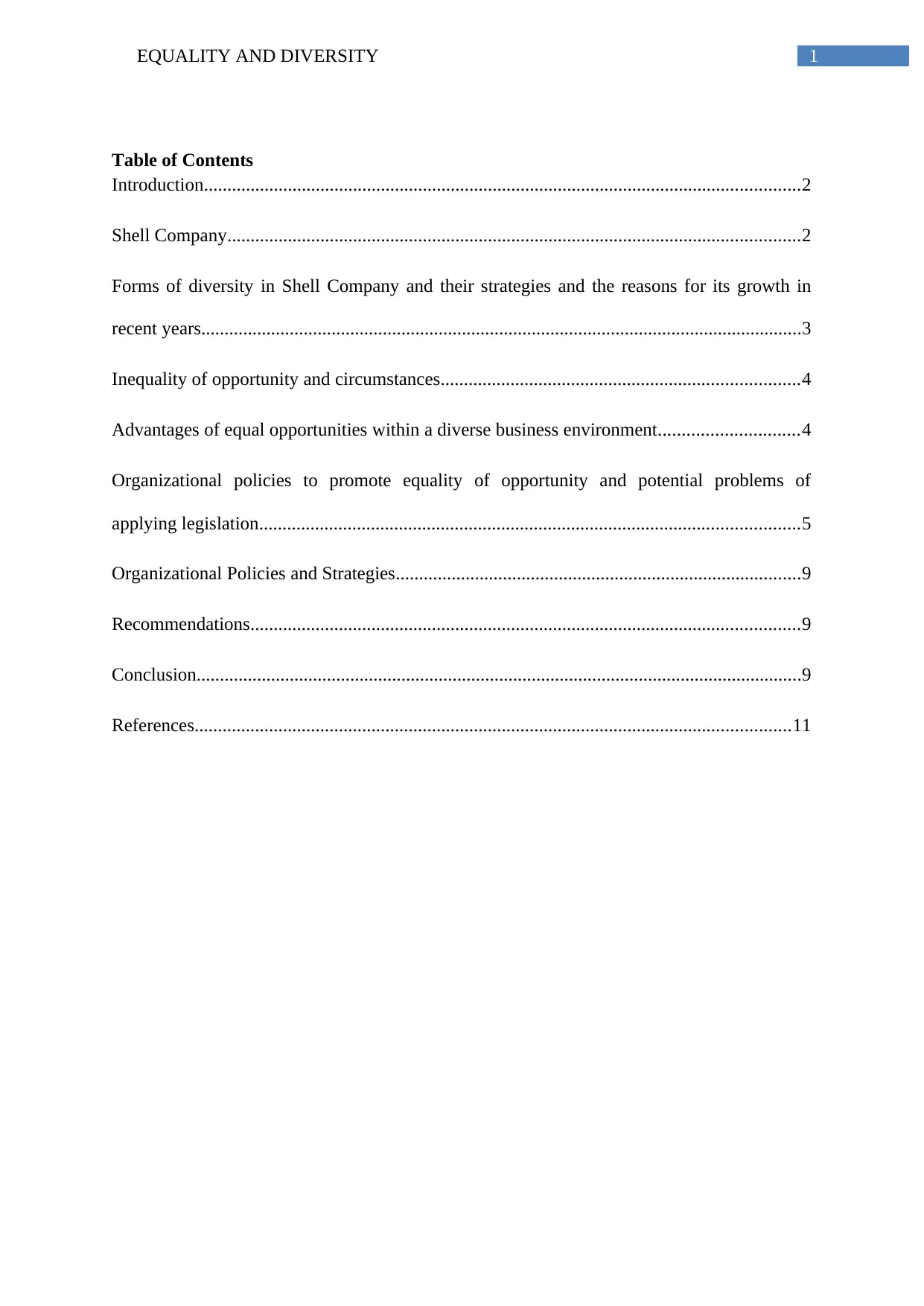
1EQUALITY AND DIVERSITY
Table of Contents
Introduction................................................................................................................................2
Shell Company...........................................................................................................................2
Forms of diversity in Shell Company and their strategies and the reasons for its growth in
recent years.................................................................................................................................3
Inequality of opportunity and circumstances.............................................................................4
Advantages of equal opportunities within a diverse business environment..............................4
Organizational policies to promote equality of opportunity and potential problems of
applying legislation....................................................................................................................5
Organizational Policies and Strategies.......................................................................................9
Recommendations......................................................................................................................9
Conclusion..................................................................................................................................9
References................................................................................................................................11
Table of Contents
Introduction................................................................................................................................2
Shell Company...........................................................................................................................2
Forms of diversity in Shell Company and their strategies and the reasons for its growth in
recent years.................................................................................................................................3
Inequality of opportunity and circumstances.............................................................................4
Advantages of equal opportunities within a diverse business environment..............................4
Organizational policies to promote equality of opportunity and potential problems of
applying legislation....................................................................................................................5
Organizational Policies and Strategies.......................................................................................9
Recommendations......................................................................................................................9
Conclusion..................................................................................................................................9
References................................................................................................................................11
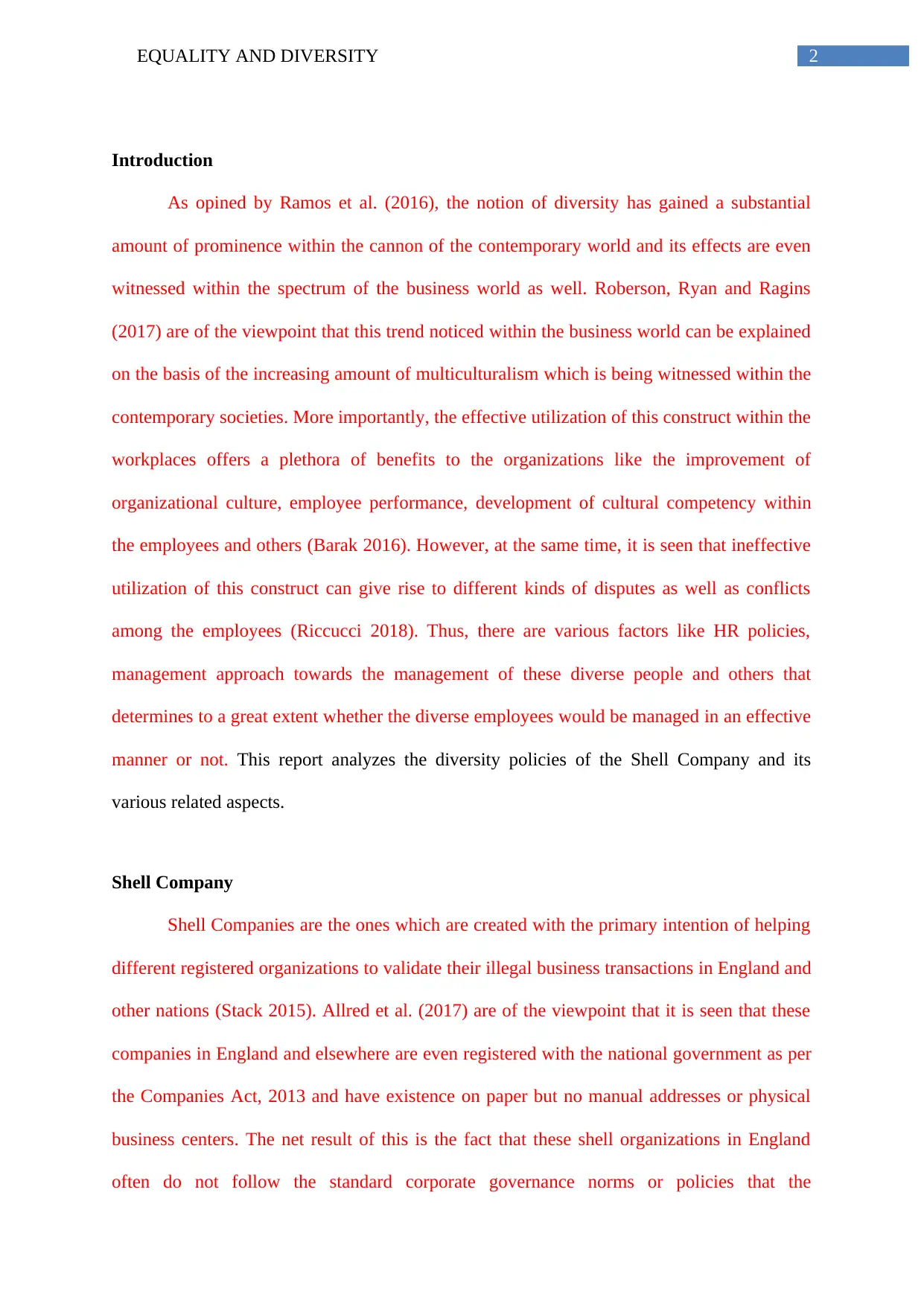
2EQUALITY AND DIVERSITY
Introduction
As opined by Ramos et al. (2016), the notion of diversity has gained a substantial
amount of prominence within the cannon of the contemporary world and its effects are even
witnessed within the spectrum of the business world as well. Roberson, Ryan and Ragins
(2017) are of the viewpoint that this trend noticed within the business world can be explained
on the basis of the increasing amount of multiculturalism which is being witnessed within the
contemporary societies. More importantly, the effective utilization of this construct within the
workplaces offers a plethora of benefits to the organizations like the improvement of
organizational culture, employee performance, development of cultural competency within
the employees and others (Barak 2016). However, at the same time, it is seen that ineffective
utilization of this construct can give rise to different kinds of disputes as well as conflicts
among the employees (Riccucci 2018). Thus, there are various factors like HR policies,
management approach towards the management of these diverse people and others that
determines to a great extent whether the diverse employees would be managed in an effective
manner or not. This report analyzes the diversity policies of the Shell Company and its
various related aspects.
Shell Company
Shell Companies are the ones which are created with the primary intention of helping
different registered organizations to validate their illegal business transactions in England and
other nations (Stack 2015). Allred et al. (2017) are of the viewpoint that it is seen that these
companies in England and elsewhere are even registered with the national government as per
the Companies Act, 2013 and have existence on paper but no manual addresses or physical
business centers. The net result of this is the fact that these shell organizations in England
often do not follow the standard corporate governance norms or policies that the
Introduction
As opined by Ramos et al. (2016), the notion of diversity has gained a substantial
amount of prominence within the cannon of the contemporary world and its effects are even
witnessed within the spectrum of the business world as well. Roberson, Ryan and Ragins
(2017) are of the viewpoint that this trend noticed within the business world can be explained
on the basis of the increasing amount of multiculturalism which is being witnessed within the
contemporary societies. More importantly, the effective utilization of this construct within the
workplaces offers a plethora of benefits to the organizations like the improvement of
organizational culture, employee performance, development of cultural competency within
the employees and others (Barak 2016). However, at the same time, it is seen that ineffective
utilization of this construct can give rise to different kinds of disputes as well as conflicts
among the employees (Riccucci 2018). Thus, there are various factors like HR policies,
management approach towards the management of these diverse people and others that
determines to a great extent whether the diverse employees would be managed in an effective
manner or not. This report analyzes the diversity policies of the Shell Company and its
various related aspects.
Shell Company
Shell Companies are the ones which are created with the primary intention of helping
different registered organizations to validate their illegal business transactions in England and
other nations (Stack 2015). Allred et al. (2017) are of the viewpoint that it is seen that these
companies in England and elsewhere are even registered with the national government as per
the Companies Act, 2013 and have existence on paper but no manual addresses or physical
business centers. The net result of this is the fact that these shell organizations in England
often do not follow the standard corporate governance norms or policies that the
⊘ This is a preview!⊘
Do you want full access?
Subscribe today to unlock all pages.

Trusted by 1+ million students worldwide
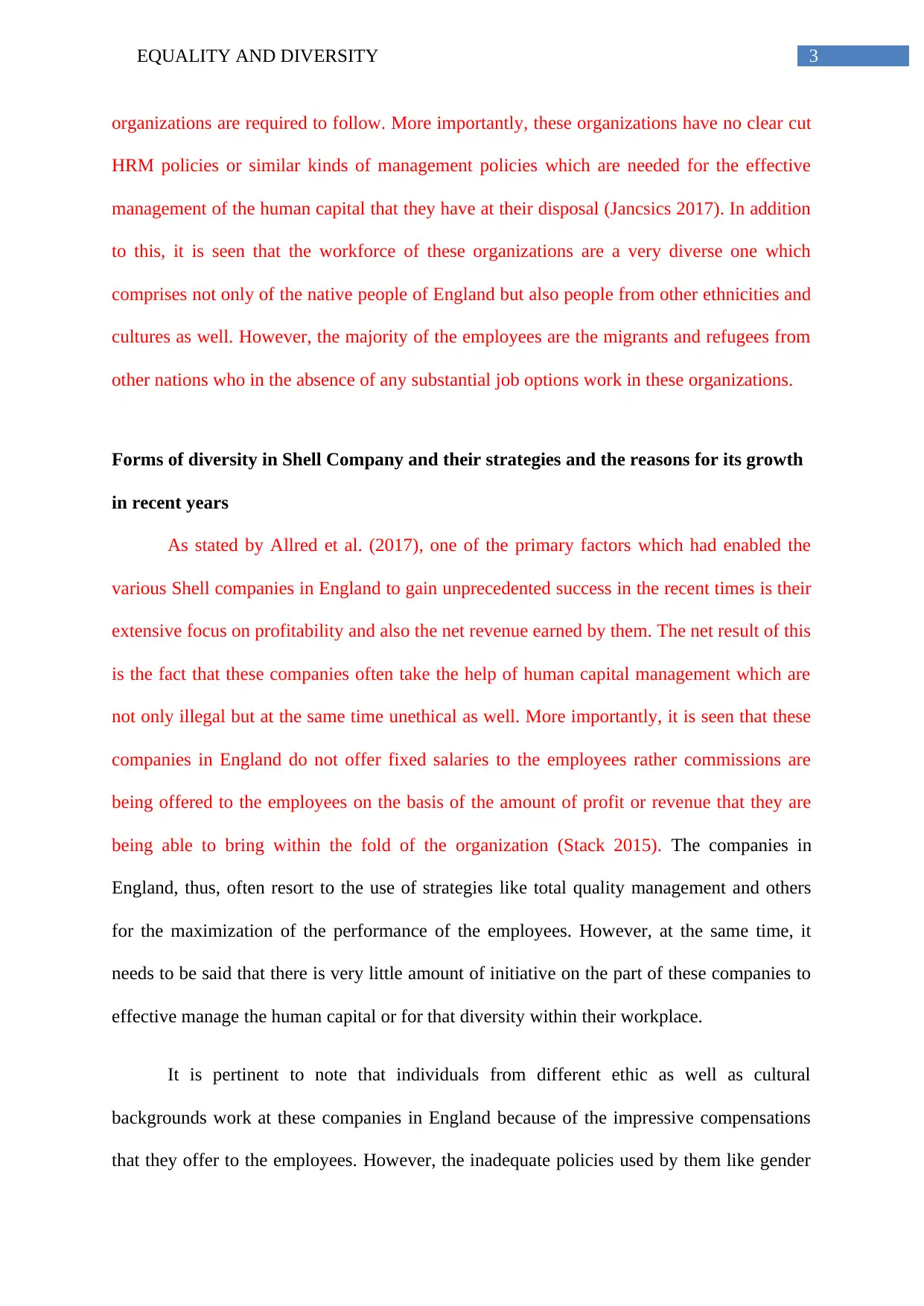
3EQUALITY AND DIVERSITY
organizations are required to follow. More importantly, these organizations have no clear cut
HRM policies or similar kinds of management policies which are needed for the effective
management of the human capital that they have at their disposal (Jancsics 2017). In addition
to this, it is seen that the workforce of these organizations are a very diverse one which
comprises not only of the native people of England but also people from other ethnicities and
cultures as well. However, the majority of the employees are the migrants and refugees from
other nations who in the absence of any substantial job options work in these organizations.
Forms of diversity in Shell Company and their strategies and the reasons for its growth
in recent years
As stated by Allred et al. (2017), one of the primary factors which had enabled the
various Shell companies in England to gain unprecedented success in the recent times is their
extensive focus on profitability and also the net revenue earned by them. The net result of this
is the fact that these companies often take the help of human capital management which are
not only illegal but at the same time unethical as well. More importantly, it is seen that these
companies in England do not offer fixed salaries to the employees rather commissions are
being offered to the employees on the basis of the amount of profit or revenue that they are
being able to bring within the fold of the organization (Stack 2015). The companies in
England, thus, often resort to the use of strategies like total quality management and others
for the maximization of the performance of the employees. However, at the same time, it
needs to be said that there is very little amount of initiative on the part of these companies to
effective manage the human capital or for that diversity within their workplace.
It is pertinent to note that individuals from different ethic as well as cultural
backgrounds work at these companies in England because of the impressive compensations
that they offer to the employees. However, the inadequate policies used by them like gender
organizations are required to follow. More importantly, these organizations have no clear cut
HRM policies or similar kinds of management policies which are needed for the effective
management of the human capital that they have at their disposal (Jancsics 2017). In addition
to this, it is seen that the workforce of these organizations are a very diverse one which
comprises not only of the native people of England but also people from other ethnicities and
cultures as well. However, the majority of the employees are the migrants and refugees from
other nations who in the absence of any substantial job options work in these organizations.
Forms of diversity in Shell Company and their strategies and the reasons for its growth
in recent years
As stated by Allred et al. (2017), one of the primary factors which had enabled the
various Shell companies in England to gain unprecedented success in the recent times is their
extensive focus on profitability and also the net revenue earned by them. The net result of this
is the fact that these companies often take the help of human capital management which are
not only illegal but at the same time unethical as well. More importantly, it is seen that these
companies in England do not offer fixed salaries to the employees rather commissions are
being offered to the employees on the basis of the amount of profit or revenue that they are
being able to bring within the fold of the organization (Stack 2015). The companies in
England, thus, often resort to the use of strategies like total quality management and others
for the maximization of the performance of the employees. However, at the same time, it
needs to be said that there is very little amount of initiative on the part of these companies to
effective manage the human capital or for that diversity within their workplace.
It is pertinent to note that individuals from different ethic as well as cultural
backgrounds work at these companies in England because of the impressive compensations
that they offer to the employees. However, the inadequate policies used by them like gender
Paraphrase This Document
Need a fresh take? Get an instant paraphrase of this document with our AI Paraphraser
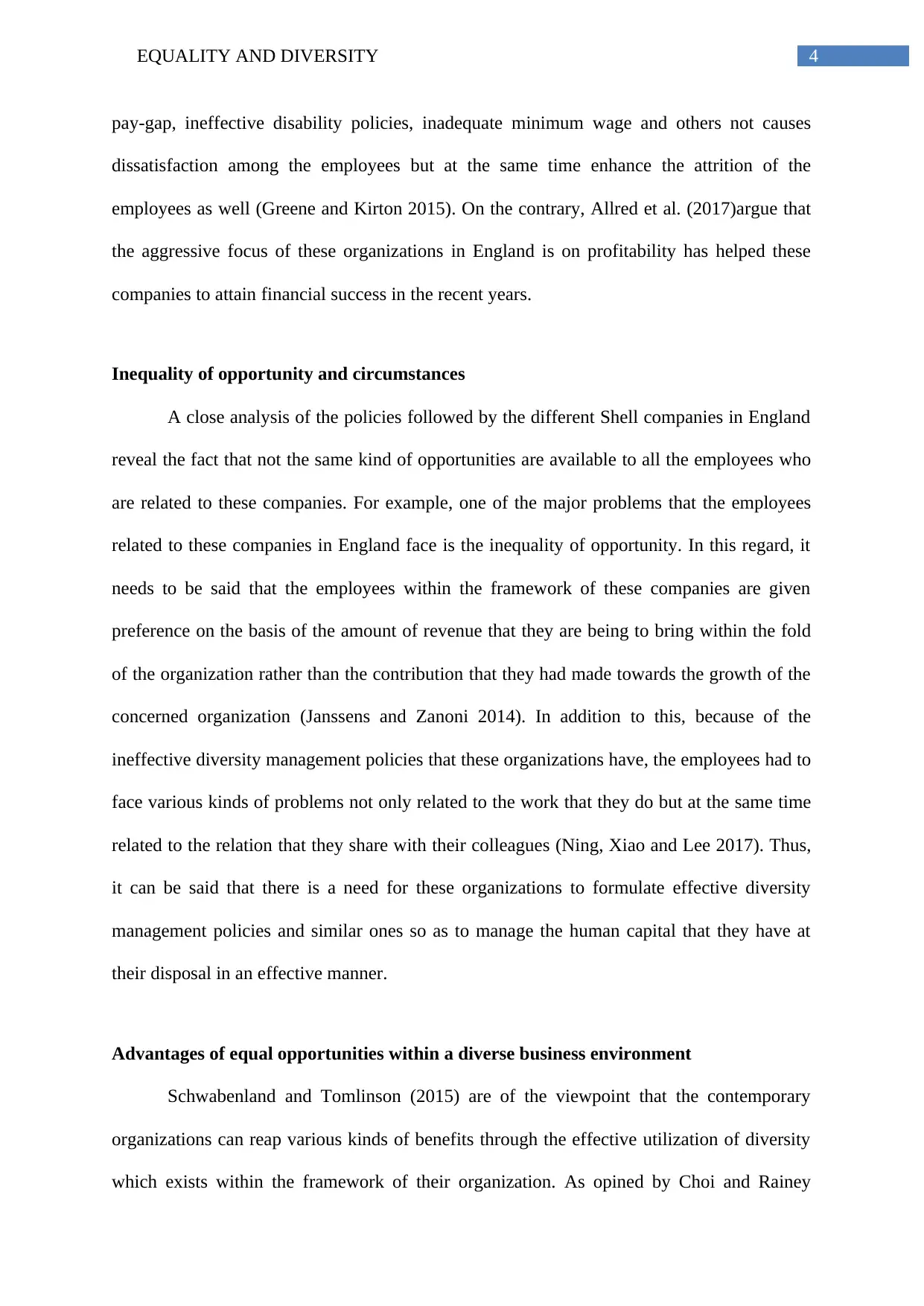
4EQUALITY AND DIVERSITY
pay-gap, ineffective disability policies, inadequate minimum wage and others not causes
dissatisfaction among the employees but at the same time enhance the attrition of the
employees as well (Greene and Kirton 2015). On the contrary, Allred et al. (2017)argue that
the aggressive focus of these organizations in England is on profitability has helped these
companies to attain financial success in the recent years.
Inequality of opportunity and circumstances
A close analysis of the policies followed by the different Shell companies in England
reveal the fact that not the same kind of opportunities are available to all the employees who
are related to these companies. For example, one of the major problems that the employees
related to these companies in England face is the inequality of opportunity. In this regard, it
needs to be said that the employees within the framework of these companies are given
preference on the basis of the amount of revenue that they are being to bring within the fold
of the organization rather than the contribution that they had made towards the growth of the
concerned organization (Janssens and Zanoni 2014). In addition to this, because of the
ineffective diversity management policies that these organizations have, the employees had to
face various kinds of problems not only related to the work that they do but at the same time
related to the relation that they share with their colleagues (Ning, Xiao and Lee 2017). Thus,
it can be said that there is a need for these organizations to formulate effective diversity
management policies and similar ones so as to manage the human capital that they have at
their disposal in an effective manner.
Advantages of equal opportunities within a diverse business environment
Schwabenland and Tomlinson (2015) are of the viewpoint that the contemporary
organizations can reap various kinds of benefits through the effective utilization of diversity
which exists within the framework of their organization. As opined by Choi and Rainey
pay-gap, ineffective disability policies, inadequate minimum wage and others not causes
dissatisfaction among the employees but at the same time enhance the attrition of the
employees as well (Greene and Kirton 2015). On the contrary, Allred et al. (2017)argue that
the aggressive focus of these organizations in England is on profitability has helped these
companies to attain financial success in the recent years.
Inequality of opportunity and circumstances
A close analysis of the policies followed by the different Shell companies in England
reveal the fact that not the same kind of opportunities are available to all the employees who
are related to these companies. For example, one of the major problems that the employees
related to these companies in England face is the inequality of opportunity. In this regard, it
needs to be said that the employees within the framework of these companies are given
preference on the basis of the amount of revenue that they are being to bring within the fold
of the organization rather than the contribution that they had made towards the growth of the
concerned organization (Janssens and Zanoni 2014). In addition to this, because of the
ineffective diversity management policies that these organizations have, the employees had to
face various kinds of problems not only related to the work that they do but at the same time
related to the relation that they share with their colleagues (Ning, Xiao and Lee 2017). Thus,
it can be said that there is a need for these organizations to formulate effective diversity
management policies and similar ones so as to manage the human capital that they have at
their disposal in an effective manner.
Advantages of equal opportunities within a diverse business environment
Schwabenland and Tomlinson (2015) are of the viewpoint that the contemporary
organizations can reap various kinds of benefits through the effective utilization of diversity
which exists within the framework of their organization. As opined by Choi and Rainey
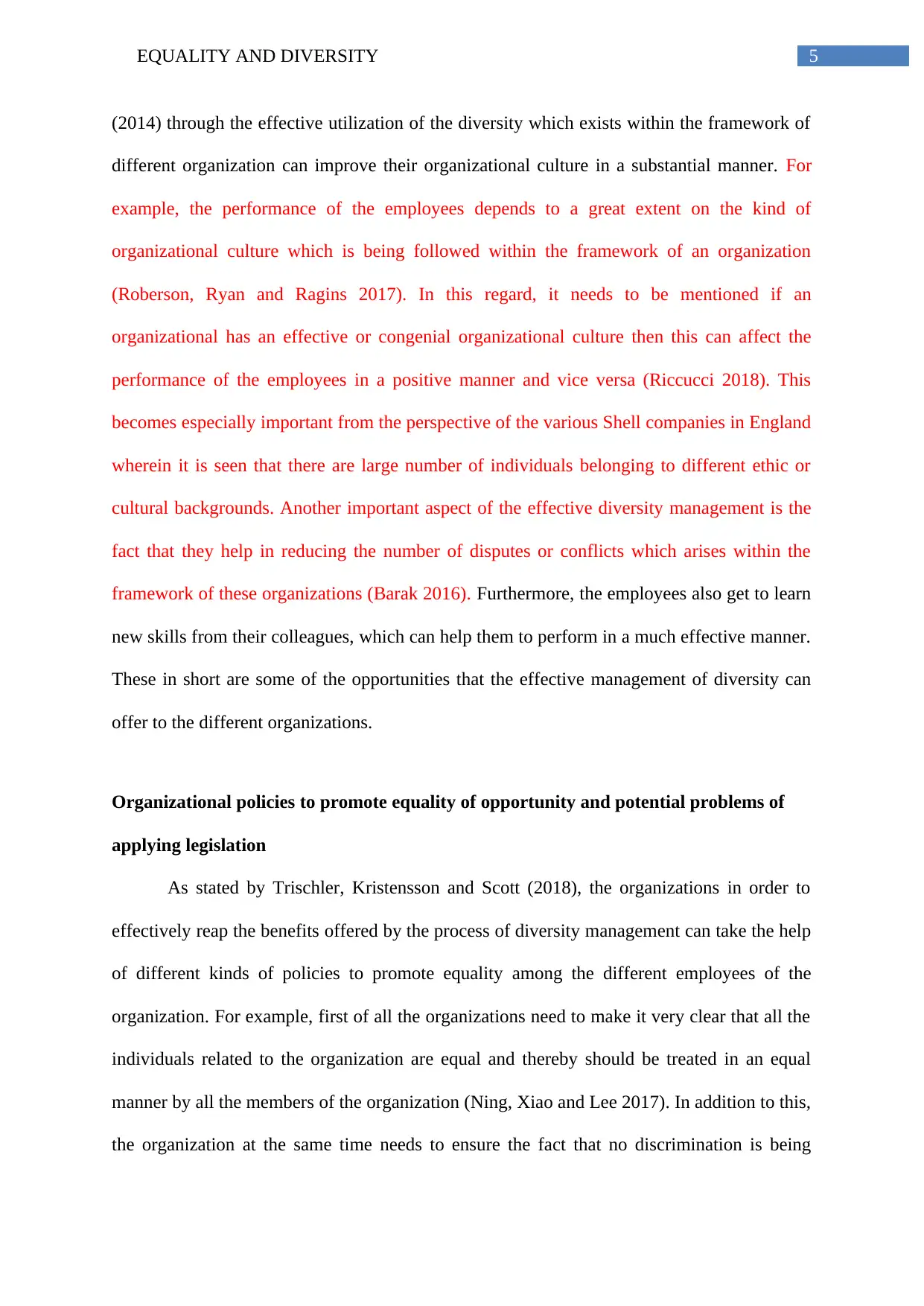
5EQUALITY AND DIVERSITY
(2014) through the effective utilization of the diversity which exists within the framework of
different organization can improve their organizational culture in a substantial manner. For
example, the performance of the employees depends to a great extent on the kind of
organizational culture which is being followed within the framework of an organization
(Roberson, Ryan and Ragins 2017). In this regard, it needs to be mentioned if an
organizational has an effective or congenial organizational culture then this can affect the
performance of the employees in a positive manner and vice versa (Riccucci 2018). This
becomes especially important from the perspective of the various Shell companies in England
wherein it is seen that there are large number of individuals belonging to different ethic or
cultural backgrounds. Another important aspect of the effective diversity management is the
fact that they help in reducing the number of disputes or conflicts which arises within the
framework of these organizations (Barak 2016). Furthermore, the employees also get to learn
new skills from their colleagues, which can help them to perform in a much effective manner.
These in short are some of the opportunities that the effective management of diversity can
offer to the different organizations.
Organizational policies to promote equality of opportunity and potential problems of
applying legislation
As stated by Trischler, Kristensson and Scott (2018), the organizations in order to
effectively reap the benefits offered by the process of diversity management can take the help
of different kinds of policies to promote equality among the different employees of the
organization. For example, first of all the organizations need to make it very clear that all the
individuals related to the organization are equal and thereby should be treated in an equal
manner by all the members of the organization (Ning, Xiao and Lee 2017). In addition to this,
the organization at the same time needs to ensure the fact that no discrimination is being
(2014) through the effective utilization of the diversity which exists within the framework of
different organization can improve their organizational culture in a substantial manner. For
example, the performance of the employees depends to a great extent on the kind of
organizational culture which is being followed within the framework of an organization
(Roberson, Ryan and Ragins 2017). In this regard, it needs to be mentioned if an
organizational has an effective or congenial organizational culture then this can affect the
performance of the employees in a positive manner and vice versa (Riccucci 2018). This
becomes especially important from the perspective of the various Shell companies in England
wherein it is seen that there are large number of individuals belonging to different ethic or
cultural backgrounds. Another important aspect of the effective diversity management is the
fact that they help in reducing the number of disputes or conflicts which arises within the
framework of these organizations (Barak 2016). Furthermore, the employees also get to learn
new skills from their colleagues, which can help them to perform in a much effective manner.
These in short are some of the opportunities that the effective management of diversity can
offer to the different organizations.
Organizational policies to promote equality of opportunity and potential problems of
applying legislation
As stated by Trischler, Kristensson and Scott (2018), the organizations in order to
effectively reap the benefits offered by the process of diversity management can take the help
of different kinds of policies to promote equality among the different employees of the
organization. For example, first of all the organizations need to make it very clear that all the
individuals related to the organization are equal and thereby should be treated in an equal
manner by all the members of the organization (Ning, Xiao and Lee 2017). In addition to this,
the organization at the same time needs to ensure the fact that no discrimination is being
⊘ This is a preview!⊘
Do you want full access?
Subscribe today to unlock all pages.

Trusted by 1+ million students worldwide
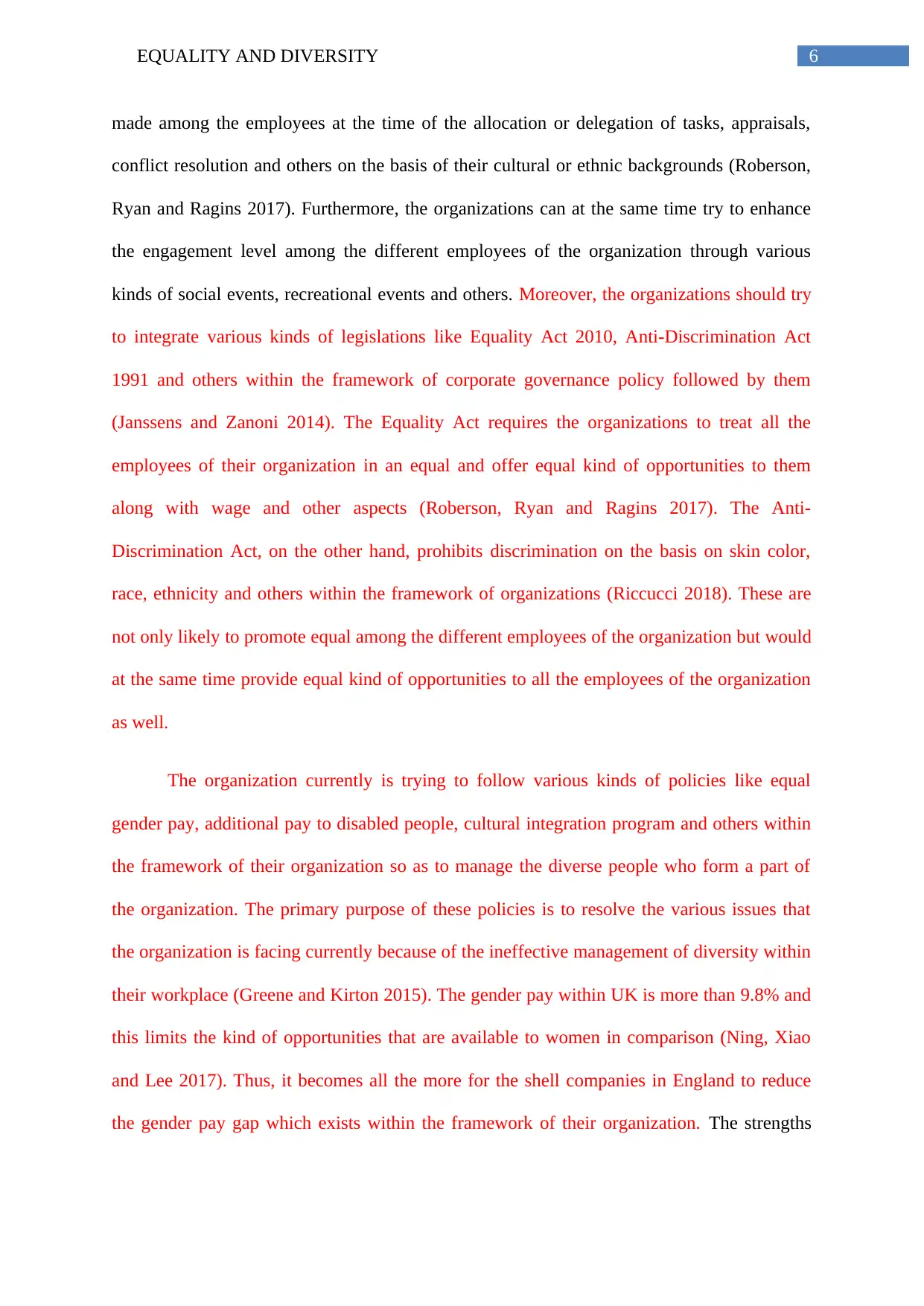
6EQUALITY AND DIVERSITY
made among the employees at the time of the allocation or delegation of tasks, appraisals,
conflict resolution and others on the basis of their cultural or ethnic backgrounds (Roberson,
Ryan and Ragins 2017). Furthermore, the organizations can at the same time try to enhance
the engagement level among the different employees of the organization through various
kinds of social events, recreational events and others. Moreover, the organizations should try
to integrate various kinds of legislations like Equality Act 2010, Anti-Discrimination Act
1991 and others within the framework of corporate governance policy followed by them
(Janssens and Zanoni 2014). The Equality Act requires the organizations to treat all the
employees of their organization in an equal and offer equal kind of opportunities to them
along with wage and other aspects (Roberson, Ryan and Ragins 2017). The Anti-
Discrimination Act, on the other hand, prohibits discrimination on the basis on skin color,
race, ethnicity and others within the framework of organizations (Riccucci 2018). These are
not only likely to promote equal among the different employees of the organization but would
at the same time provide equal kind of opportunities to all the employees of the organization
as well.
The organization currently is trying to follow various kinds of policies like equal
gender pay, additional pay to disabled people, cultural integration program and others within
the framework of their organization so as to manage the diverse people who form a part of
the organization. The primary purpose of these policies is to resolve the various issues that
the organization is facing currently because of the ineffective management of diversity within
their workplace (Greene and Kirton 2015). The gender pay within UK is more than 9.8% and
this limits the kind of opportunities that are available to women in comparison (Ning, Xiao
and Lee 2017). Thus, it becomes all the more for the shell companies in England to reduce
the gender pay gap which exists within the framework of their organization. The strengths
made among the employees at the time of the allocation or delegation of tasks, appraisals,
conflict resolution and others on the basis of their cultural or ethnic backgrounds (Roberson,
Ryan and Ragins 2017). Furthermore, the organizations can at the same time try to enhance
the engagement level among the different employees of the organization through various
kinds of social events, recreational events and others. Moreover, the organizations should try
to integrate various kinds of legislations like Equality Act 2010, Anti-Discrimination Act
1991 and others within the framework of corporate governance policy followed by them
(Janssens and Zanoni 2014). The Equality Act requires the organizations to treat all the
employees of their organization in an equal and offer equal kind of opportunities to them
along with wage and other aspects (Roberson, Ryan and Ragins 2017). The Anti-
Discrimination Act, on the other hand, prohibits discrimination on the basis on skin color,
race, ethnicity and others within the framework of organizations (Riccucci 2018). These are
not only likely to promote equal among the different employees of the organization but would
at the same time provide equal kind of opportunities to all the employees of the organization
as well.
The organization currently is trying to follow various kinds of policies like equal
gender pay, additional pay to disabled people, cultural integration program and others within
the framework of their organization so as to manage the diverse people who form a part of
the organization. The primary purpose of these policies is to resolve the various issues that
the organization is facing currently because of the ineffective management of diversity within
their workplace (Greene and Kirton 2015). The gender pay within UK is more than 9.8% and
this limits the kind of opportunities that are available to women in comparison (Ning, Xiao
and Lee 2017). Thus, it becomes all the more for the shell companies in England to reduce
the gender pay gap which exists within the framework of their organization. The strengths
Paraphrase This Document
Need a fresh take? Get an instant paraphrase of this document with our AI Paraphraser
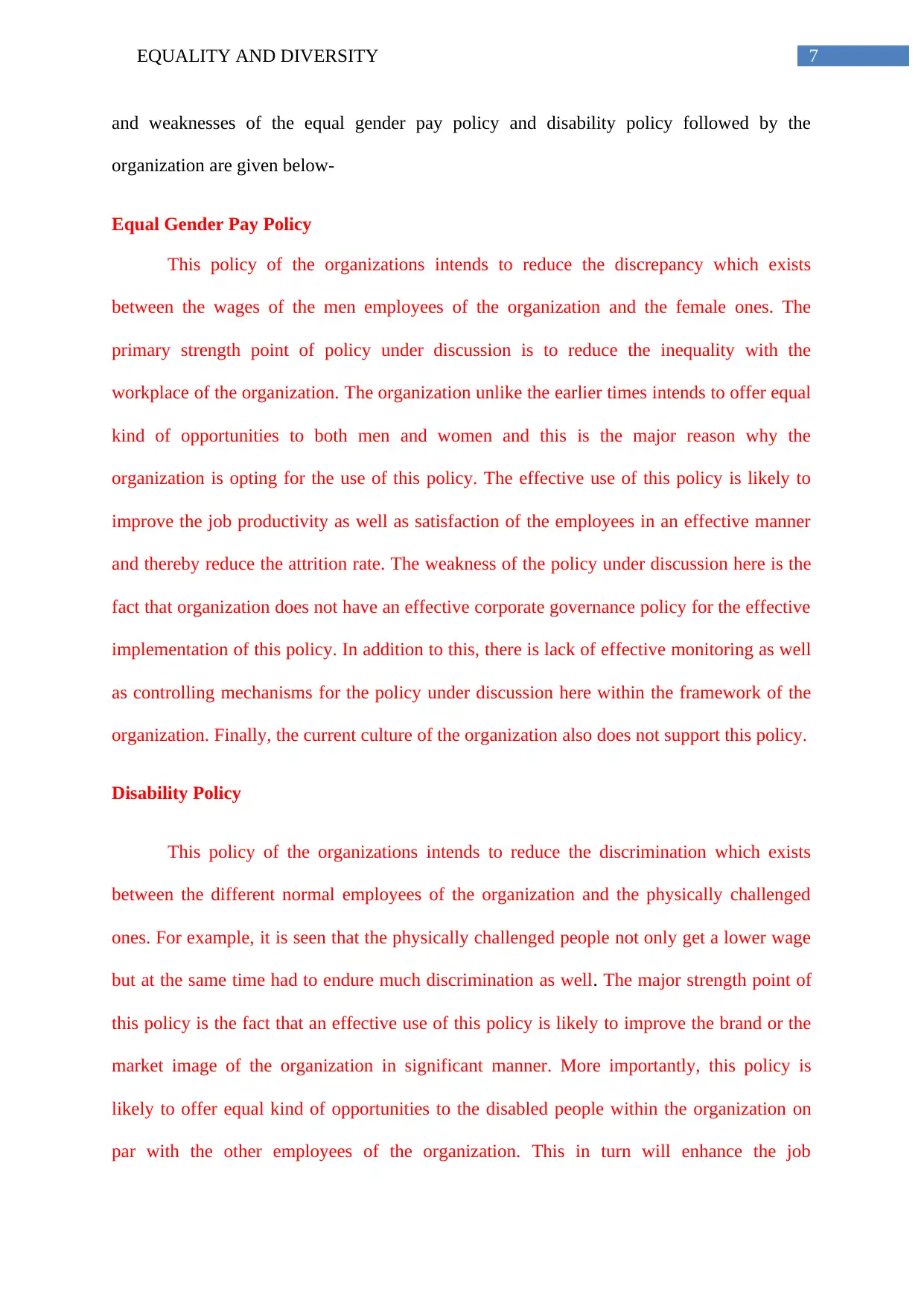
7EQUALITY AND DIVERSITY
and weaknesses of the equal gender pay policy and disability policy followed by the
organization are given below-
Equal Gender Pay Policy
This policy of the organizations intends to reduce the discrepancy which exists
between the wages of the men employees of the organization and the female ones. The
primary strength point of policy under discussion is to reduce the inequality with the
workplace of the organization. The organization unlike the earlier times intends to offer equal
kind of opportunities to both men and women and this is the major reason why the
organization is opting for the use of this policy. The effective use of this policy is likely to
improve the job productivity as well as satisfaction of the employees in an effective manner
and thereby reduce the attrition rate. The weakness of the policy under discussion here is the
fact that organization does not have an effective corporate governance policy for the effective
implementation of this policy. In addition to this, there is lack of effective monitoring as well
as controlling mechanisms for the policy under discussion here within the framework of the
organization. Finally, the current culture of the organization also does not support this policy.
Disability Policy
This policy of the organizations intends to reduce the discrimination which exists
between the different normal employees of the organization and the physically challenged
ones. For example, it is seen that the physically challenged people not only get a lower wage
but at the same time had to endure much discrimination as well. The major strength point of
this policy is the fact that an effective use of this policy is likely to improve the brand or the
market image of the organization in significant manner. More importantly, this policy is
likely to offer equal kind of opportunities to the disabled people within the organization on
par with the other employees of the organization. This in turn will enhance the job
and weaknesses of the equal gender pay policy and disability policy followed by the
organization are given below-
Equal Gender Pay Policy
This policy of the organizations intends to reduce the discrepancy which exists
between the wages of the men employees of the organization and the female ones. The
primary strength point of policy under discussion is to reduce the inequality with the
workplace of the organization. The organization unlike the earlier times intends to offer equal
kind of opportunities to both men and women and this is the major reason why the
organization is opting for the use of this policy. The effective use of this policy is likely to
improve the job productivity as well as satisfaction of the employees in an effective manner
and thereby reduce the attrition rate. The weakness of the policy under discussion here is the
fact that organization does not have an effective corporate governance policy for the effective
implementation of this policy. In addition to this, there is lack of effective monitoring as well
as controlling mechanisms for the policy under discussion here within the framework of the
organization. Finally, the current culture of the organization also does not support this policy.
Disability Policy
This policy of the organizations intends to reduce the discrimination which exists
between the different normal employees of the organization and the physically challenged
ones. For example, it is seen that the physically challenged people not only get a lower wage
but at the same time had to endure much discrimination as well. The major strength point of
this policy is the fact that an effective use of this policy is likely to improve the brand or the
market image of the organization in significant manner. More importantly, this policy is
likely to offer equal kind of opportunities to the disabled people within the organization on
par with the other employees of the organization. This in turn will enhance the job
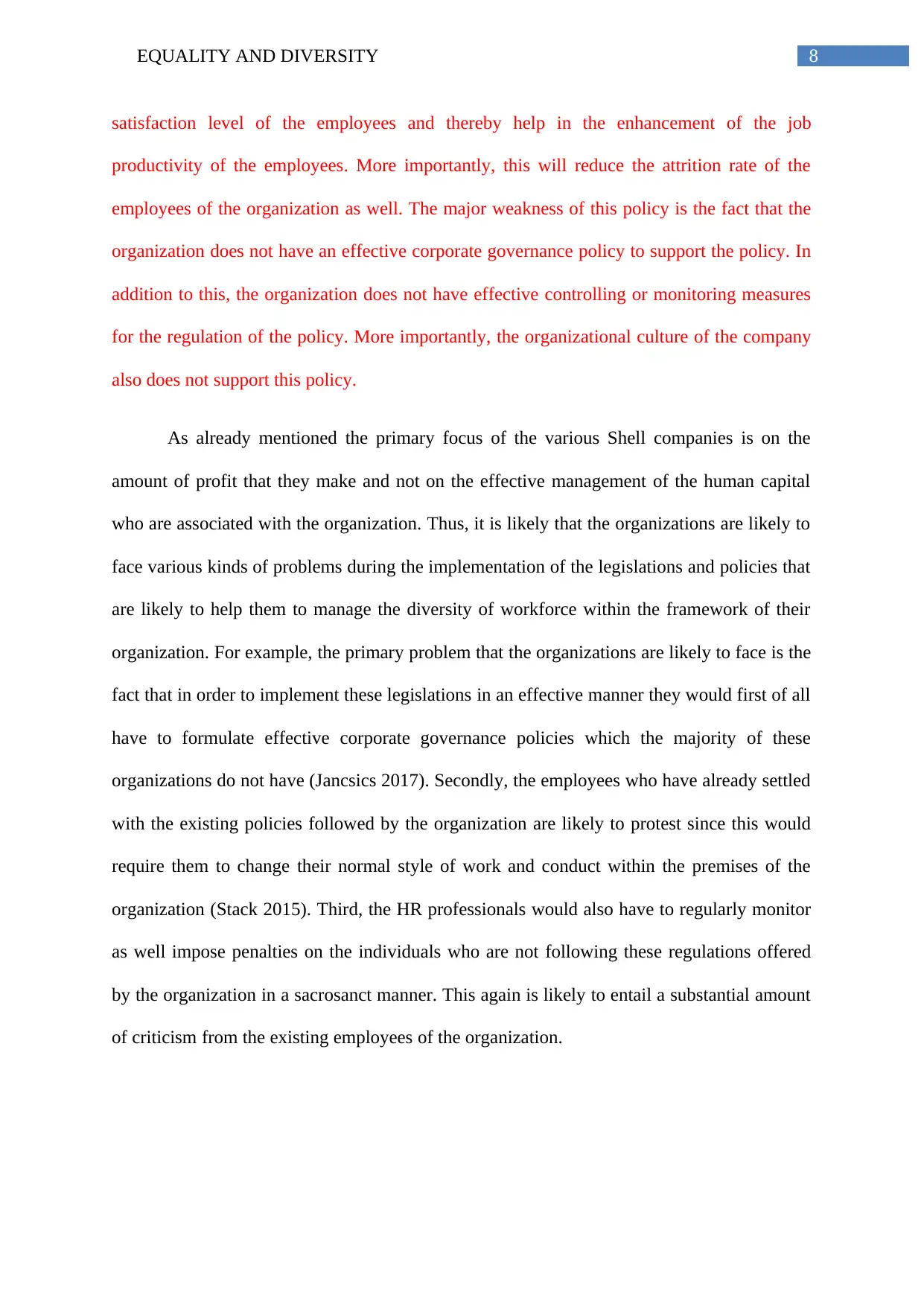
8EQUALITY AND DIVERSITY
satisfaction level of the employees and thereby help in the enhancement of the job
productivity of the employees. More importantly, this will reduce the attrition rate of the
employees of the organization as well. The major weakness of this policy is the fact that the
organization does not have an effective corporate governance policy to support the policy. In
addition to this, the organization does not have effective controlling or monitoring measures
for the regulation of the policy. More importantly, the organizational culture of the company
also does not support this policy.
As already mentioned the primary focus of the various Shell companies is on the
amount of profit that they make and not on the effective management of the human capital
who are associated with the organization. Thus, it is likely that the organizations are likely to
face various kinds of problems during the implementation of the legislations and policies that
are likely to help them to manage the diversity of workforce within the framework of their
organization. For example, the primary problem that the organizations are likely to face is the
fact that in order to implement these legislations in an effective manner they would first of all
have to formulate effective corporate governance policies which the majority of these
organizations do not have (Jancsics 2017). Secondly, the employees who have already settled
with the existing policies followed by the organization are likely to protest since this would
require them to change their normal style of work and conduct within the premises of the
organization (Stack 2015). Third, the HR professionals would also have to regularly monitor
as well impose penalties on the individuals who are not following these regulations offered
by the organization in a sacrosanct manner. This again is likely to entail a substantial amount
of criticism from the existing employees of the organization.
satisfaction level of the employees and thereby help in the enhancement of the job
productivity of the employees. More importantly, this will reduce the attrition rate of the
employees of the organization as well. The major weakness of this policy is the fact that the
organization does not have an effective corporate governance policy to support the policy. In
addition to this, the organization does not have effective controlling or monitoring measures
for the regulation of the policy. More importantly, the organizational culture of the company
also does not support this policy.
As already mentioned the primary focus of the various Shell companies is on the
amount of profit that they make and not on the effective management of the human capital
who are associated with the organization. Thus, it is likely that the organizations are likely to
face various kinds of problems during the implementation of the legislations and policies that
are likely to help them to manage the diversity of workforce within the framework of their
organization. For example, the primary problem that the organizations are likely to face is the
fact that in order to implement these legislations in an effective manner they would first of all
have to formulate effective corporate governance policies which the majority of these
organizations do not have (Jancsics 2017). Secondly, the employees who have already settled
with the existing policies followed by the organization are likely to protest since this would
require them to change their normal style of work and conduct within the premises of the
organization (Stack 2015). Third, the HR professionals would also have to regularly monitor
as well impose penalties on the individuals who are not following these regulations offered
by the organization in a sacrosanct manner. This again is likely to entail a substantial amount
of criticism from the existing employees of the organization.
⊘ This is a preview!⊘
Do you want full access?
Subscribe today to unlock all pages.

Trusted by 1+ million students worldwide
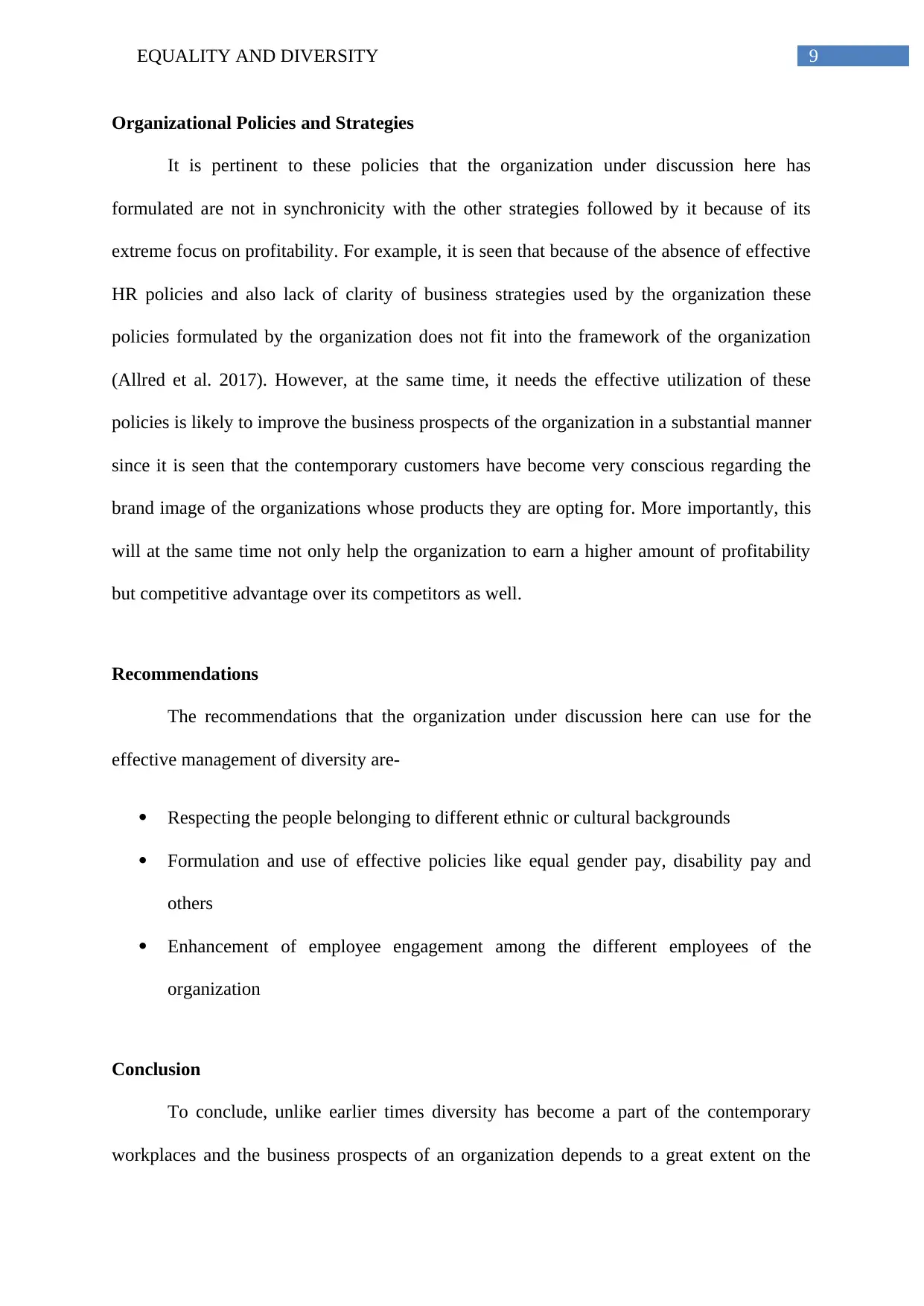
9EQUALITY AND DIVERSITY
Organizational Policies and Strategies
It is pertinent to these policies that the organization under discussion here has
formulated are not in synchronicity with the other strategies followed by it because of its
extreme focus on profitability. For example, it is seen that because of the absence of effective
HR policies and also lack of clarity of business strategies used by the organization these
policies formulated by the organization does not fit into the framework of the organization
(Allred et al. 2017). However, at the same time, it needs the effective utilization of these
policies is likely to improve the business prospects of the organization in a substantial manner
since it is seen that the contemporary customers have become very conscious regarding the
brand image of the organizations whose products they are opting for. More importantly, this
will at the same time not only help the organization to earn a higher amount of profitability
but competitive advantage over its competitors as well.
Recommendations
The recommendations that the organization under discussion here can use for the
effective management of diversity are-
Respecting the people belonging to different ethnic or cultural backgrounds
Formulation and use of effective policies like equal gender pay, disability pay and
others
Enhancement of employee engagement among the different employees of the
organization
Conclusion
To conclude, unlike earlier times diversity has become a part of the contemporary
workplaces and the business prospects of an organization depends to a great extent on the
Organizational Policies and Strategies
It is pertinent to these policies that the organization under discussion here has
formulated are not in synchronicity with the other strategies followed by it because of its
extreme focus on profitability. For example, it is seen that because of the absence of effective
HR policies and also lack of clarity of business strategies used by the organization these
policies formulated by the organization does not fit into the framework of the organization
(Allred et al. 2017). However, at the same time, it needs the effective utilization of these
policies is likely to improve the business prospects of the organization in a substantial manner
since it is seen that the contemporary customers have become very conscious regarding the
brand image of the organizations whose products they are opting for. More importantly, this
will at the same time not only help the organization to earn a higher amount of profitability
but competitive advantage over its competitors as well.
Recommendations
The recommendations that the organization under discussion here can use for the
effective management of diversity are-
Respecting the people belonging to different ethnic or cultural backgrounds
Formulation and use of effective policies like equal gender pay, disability pay and
others
Enhancement of employee engagement among the different employees of the
organization
Conclusion
To conclude, unlike earlier times diversity has become a part of the contemporary
workplaces and the business prospects of an organization depends to a great extent on the
Paraphrase This Document
Need a fresh take? Get an instant paraphrase of this document with our AI Paraphraser
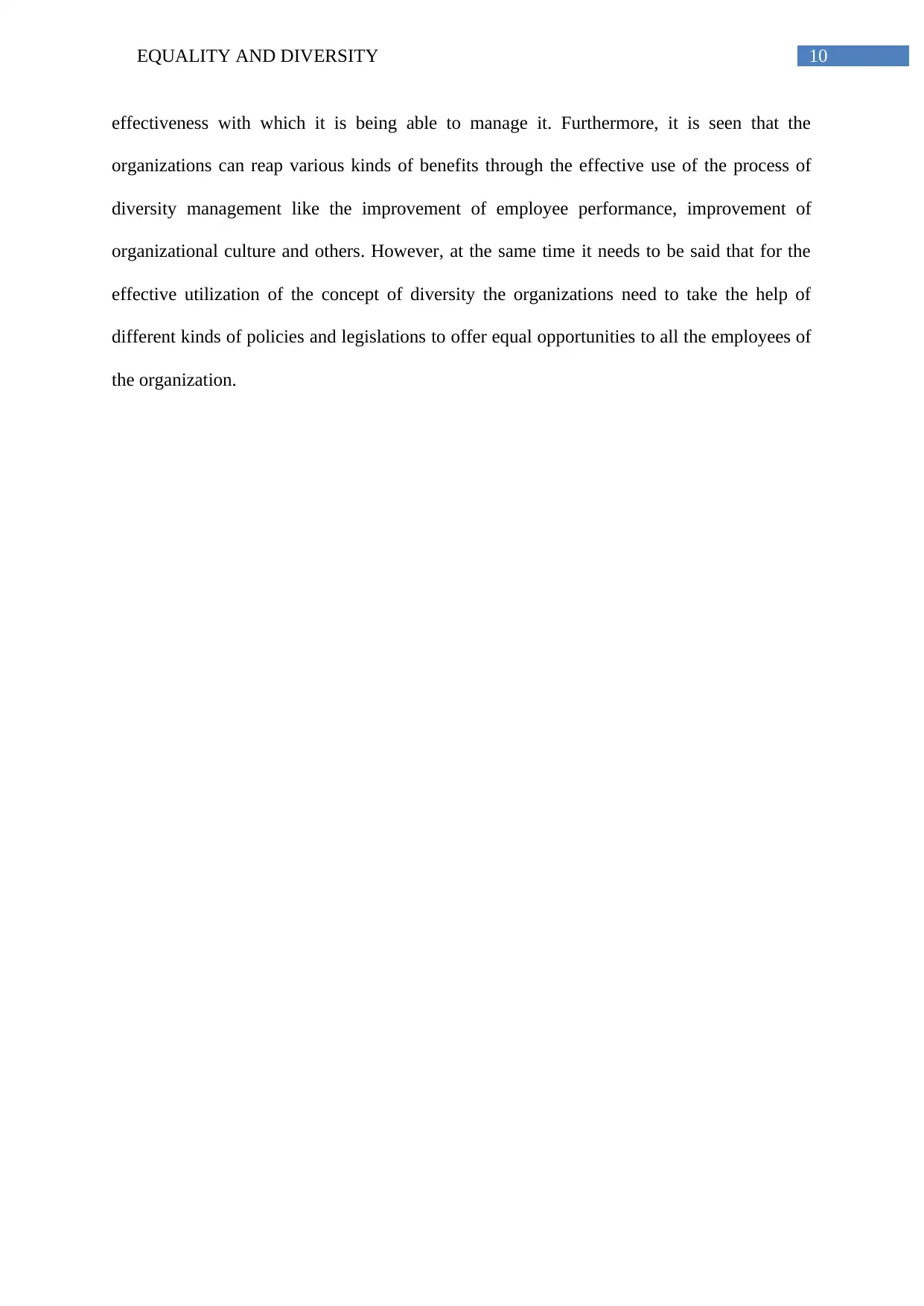
10EQUALITY AND DIVERSITY
effectiveness with which it is being able to manage it. Furthermore, it is seen that the
organizations can reap various kinds of benefits through the effective use of the process of
diversity management like the improvement of employee performance, improvement of
organizational culture and others. However, at the same time it needs to be said that for the
effective utilization of the concept of diversity the organizations need to take the help of
different kinds of policies and legislations to offer equal opportunities to all the employees of
the organization.
effectiveness with which it is being able to manage it. Furthermore, it is seen that the
organizations can reap various kinds of benefits through the effective use of the process of
diversity management like the improvement of employee performance, improvement of
organizational culture and others. However, at the same time it needs to be said that for the
effective utilization of the concept of diversity the organizations need to take the help of
different kinds of policies and legislations to offer equal opportunities to all the employees of
the organization.
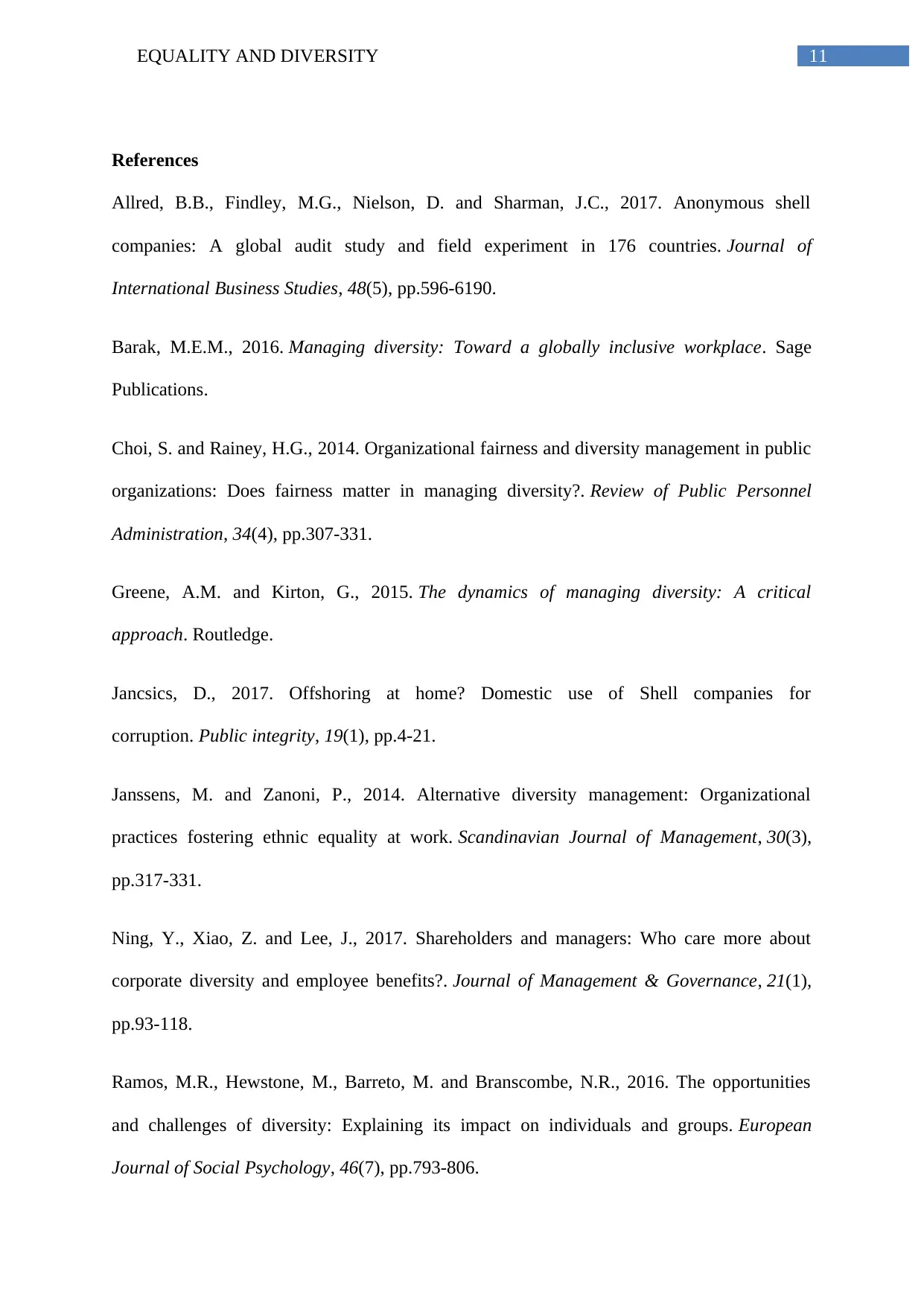
11EQUALITY AND DIVERSITY
References
Allred, B.B., Findley, M.G., Nielson, D. and Sharman, J.C., 2017. Anonymous shell
companies: A global audit study and field experiment in 176 countries. Journal of
International Business Studies, 48(5), pp.596-6190.
Barak, M.E.M., 2016. Managing diversity: Toward a globally inclusive workplace. Sage
Publications.
Choi, S. and Rainey, H.G., 2014. Organizational fairness and diversity management in public
organizations: Does fairness matter in managing diversity?. Review of Public Personnel
Administration, 34(4), pp.307-331.
Greene, A.M. and Kirton, G., 2015. The dynamics of managing diversity: A critical
approach. Routledge.
Jancsics, D., 2017. Offshoring at home? Domestic use of Shell companies for
corruption. Public integrity, 19(1), pp.4-21.
Janssens, M. and Zanoni, P., 2014. Alternative diversity management: Organizational
practices fostering ethnic equality at work. Scandinavian Journal of Management, 30(3),
pp.317-331.
Ning, Y., Xiao, Z. and Lee, J., 2017. Shareholders and managers: Who care more about
corporate diversity and employee benefits?. Journal of Management & Governance, 21(1),
pp.93-118.
Ramos, M.R., Hewstone, M., Barreto, M. and Branscombe, N.R., 2016. The opportunities
and challenges of diversity: Explaining its impact on individuals and groups. European
Journal of Social Psychology, 46(7), pp.793-806.
References
Allred, B.B., Findley, M.G., Nielson, D. and Sharman, J.C., 2017. Anonymous shell
companies: A global audit study and field experiment in 176 countries. Journal of
International Business Studies, 48(5), pp.596-6190.
Barak, M.E.M., 2016. Managing diversity: Toward a globally inclusive workplace. Sage
Publications.
Choi, S. and Rainey, H.G., 2014. Organizational fairness and diversity management in public
organizations: Does fairness matter in managing diversity?. Review of Public Personnel
Administration, 34(4), pp.307-331.
Greene, A.M. and Kirton, G., 2015. The dynamics of managing diversity: A critical
approach. Routledge.
Jancsics, D., 2017. Offshoring at home? Domestic use of Shell companies for
corruption. Public integrity, 19(1), pp.4-21.
Janssens, M. and Zanoni, P., 2014. Alternative diversity management: Organizational
practices fostering ethnic equality at work. Scandinavian Journal of Management, 30(3),
pp.317-331.
Ning, Y., Xiao, Z. and Lee, J., 2017. Shareholders and managers: Who care more about
corporate diversity and employee benefits?. Journal of Management & Governance, 21(1),
pp.93-118.
Ramos, M.R., Hewstone, M., Barreto, M. and Branscombe, N.R., 2016. The opportunities
and challenges of diversity: Explaining its impact on individuals and groups. European
Journal of Social Psychology, 46(7), pp.793-806.
⊘ This is a preview!⊘
Do you want full access?
Subscribe today to unlock all pages.

Trusted by 1+ million students worldwide
1 out of 13
Related Documents
Your All-in-One AI-Powered Toolkit for Academic Success.
+13062052269
info@desklib.com
Available 24*7 on WhatsApp / Email
![[object Object]](/_next/static/media/star-bottom.7253800d.svg)
Unlock your academic potential
Copyright © 2020–2025 A2Z Services. All Rights Reserved. Developed and managed by ZUCOL.





